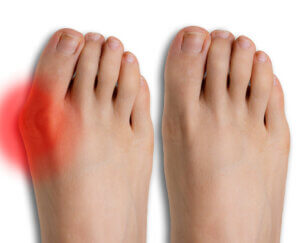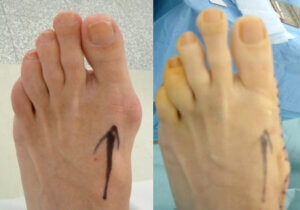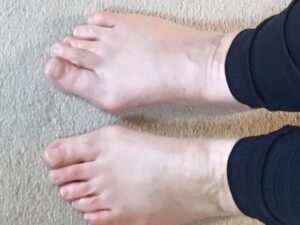Is there a best age for bunion surgery?
There is a right time and a wrong time to make a decision
What is the best age for surgery for bunions? This is asked more times than one might imagine. If I add up my surgeries on the bunion over the years, I reckon I have operated on over 3000 feet, and I am by no means an overactive foot surgeon.
The bunion, also known medically as hallux valgus, is the most common referral to podiatric surgeons, the group of podiatrists who specialise in elective surgery. You will find heaps of information about this common condition as you navigate my website. We might be obsessed with not having feet like grandmother or mother, but there is a right time and a wrong time to have surgery. This short article is really just a get you started. There are more detailed articles, and my book covers four patient case histories in great detail as my patients wrote them without removal of the gory details. I have tried to provide a brief guide based on age. Inevitably this is only one criterion, but my aim is to provide information that makes you consider your options carefully.
Let’s look at age groupings
Under Twenty

Babies can be born with a bunion, but this is rare and thought to be part of the pressure associated with the uterus; it is just as likely to have e a club-shaped foot as a bunion. The latter incidence is around 1 in 1000.
The age of bone growth maturity is around 15-17 (girls) and 16-19 (boys). In fact, it is possible to have surgery and require a repeat not just once but twice in some less common situations. My youngest patient was 14, but the most severe bunion was in a 9-year-old!
Children scar more than adults, and this can add to concerns. One of my surgeon friend’s son was 14 when he had surgery for his bunion and it came back before he was 20. The only justification for juvenile surgery (under 16) is for pain and damage to the skin with infection.
The Twenties

F was an independent woman. She wanted both feet managed for a modest deformity but wanted to travel a long haul to Australia 8 weeks after surgery. This raised the risk of blood clots. We can minimise this risk by limiting alcohol on the flight, a 75mg aspirin and flight socks, but not the Aussie sun on a wound.
Two feet v one foot
First, you must realise IF 2 feet are operated on together, you are DISABLED! This could go on for 2-16 weeks, depending on how well you do. Reoccurrence? You can be operated on at any age, but 35-45 is still best with lower risks and greater optimism for success.
‘Young’ is not so good because reoccurrence is higher than 35 upwards. However, the joint has less cartilage damage at a younger age, and if left, this could deteriorate. We can cope with general cartilage wear as long as the joint is not inflamed.
The golden rule is can you function, does the joint hurt or swell? If you can do all the activities you want, stick with the deformity but protect the skin.
The Thirties

After age 30-35, the deformity reoccurs slightly less than in earlier years following surgery. We reckon there is a 7-15% reoccurrence risk depending upon the source you read. Though sometimes it is inevitable, I am always dubious about making fast decisions when treating the big toe for bunions (Hallux valgus). However, I prefer my patients to observe caution so all the facts are laid out and understood. Read Jo’s bunion journey story.
Bunion surgery does well in 70-80% of cases, but there are 20% or so patients who may not be as satisfied as they might like, and for us, this is a great disappointment.
Starting a family after 30 is common in this day, especially for those who have not settled down or have a significant career. I have always found teachers more challenging, especially if they have been pressured to return to school too early. My patients have always done better around this age and seem to return to full activity faster. One 29-30-year-old took 3 years for her joint to return to 60 degrees of movement after large surgery. Large just meant her deformity was over 45 degrees, and after surgery, it took time to become mobile again.
The Forties
Ages – 40-59 do very well, although healing is slightly slower and pain control is effective if you follow all the ground rules. Of course, by now, the deformity might have increased, and those secondary features such as hammertoes, corns and a callus may have arisen. Combining surgery with other problems has to be considered, and recovery is longer than when younger. Bunion surgery is probably carried out more between 40 and 65 than any other age. If your GP says your bunion is not ripe yet, they mean it is not severe enough for surgery. In the UK, this can often be a term to stop the NHS from being overloaded, as waiting lists can be horrendous!

Sixty Plus
Modern 60-year-olds are much more active today, so it is impossible to apply the same attitude to someone who is not going to grow old gracefully. Jane Clare is a podiatrist and had surgery and reported her case to ConsultingFootpain. You can read her words in Tales of Foot Surgery from Jane.

My oldest patient was 94 and in good health but troubled by damaged skin. Once you cross into those upper years, healing does drop even if the pain is better tolerated by many in this age group. Local anaesthetic is much better for older people, especially if their health is poor. Simple surgery is better, and this leans on some well-established procedures. Our aim is to ensure mobility is stored as fast as possible.
One of our concerns later on in life is to ensure that patients have someone around to support their needs. You cannot go shopping after foot surgery without creating risks.
Ladies beware (and men too)
Footwear and bunion surgery don’t always mix well if you believe that this is the reason to have surgery in the first place. Younger patients under 30 may be less influenced by footwear, but surgery is not an excuse to wear shoes that once upon a time exacerbated the problem in the first case. Now I am not saying bad shoes cause bunions; they don’t, but some of those tighter shoe designs do not help the problems of having a bunion.

Leaving surgery for later is better as a rule
The Exceptions
- infection and ulceration of the skin
- severe skin damage because of pressure
- nighttime pain or continuous pain requiring painkillers
- Lesser toes dislocating
seek help for these problems. Here is a summary.
Summary
- Try to find a conservative approach to keep you comfortable.
- Very young are not ideal because bunions can reoccur
- Your joint may be stiff after surgery.
- Watch out for correctly fitted shoes after surgery.
- Patients with good mobility do better.
- Surgery, later on in life, can be prejudiced by medical problems and depend on bone quality.
- Healing quality diminishes with age.
Check out my other articles on bunions
- The Bunion hallux valgus deformity Number One
- When is surgery indicated for the bunion?
- Helping your bunion yourself
- Hallux Valgus is known as a bunion
- What do you really need to know after bunion surgery?
The Go to Book you can trust

If you want more details about the after-effects of surgery on your bunion, read these true-life journey stories and the risks behind the scenes. Read the website review (click here)

Thanks for reading ‘Bunion surgery the best age?’ by David R Tollafield
Published by Busypencilcase Communications. Est. 2015 for ConsultingFootPain

Updated 23 June 2023


Trackbacks/Pingbacks